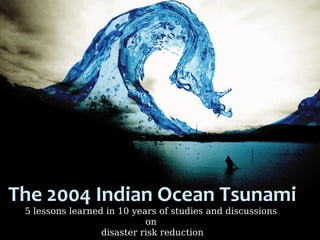10 years since and 5 lessons from the 2004 Indian Ocean Tsunami
- 1. The 2004 Indian Ocean Tsunami 5 lessons learned in 10 years of studies and discussions on disaster risk reduction
- 2. #1 Do not forget Extremely destructive tsunamis happen on century scale intervals. It was not the first of ist kind. A memory must be kept for future generations. In Banda Aceh there are memorials, now, that could preserve this memory. They must be mantained throughout the centuries.
- 3. This barge was brought 2 km inland by thewave. Today is kept as a memorial
- 4. Tsunami Museum in Banda Aceh
- 5. #2 Early warning systems are a must Early warning systems must be in place. Operational since 2013, there is a system of geophones, buoys, satellites, operated by centers in India, Indonesia, Australia. They can dispatch warns within minutes.
- 6. Evacuation drills, Banda Aceh.
- 7. #3 Technology alone is not enough Technology changes fast. Complex systems may fail. Mantainance is expensive. Institutions slow reaction to warnings may hamper emergency measures. There is the need for various measures to be in place, some of them not technology-, rather community-based (lessons #4 and #5).
- 8. Young generations need to know, remember. Visitors at the Barge memorial.
- 9. #4 Practice, education, are the keys Improve communities preparedness through exercise, drills, education of communities and governmental organizations living in disaster prone regions. Preparedness to natural hazards needs to be monitored and evaluated - for centuries to come.
- 10. Drills, exercise. Be ready. Banda Aceh.
- 11. #5 Indigenous knowledge is a warning system tool too Indigenous knowledge has developed in thousands years. There are some tools communities have developed to cope with disasters. They have often been saved and shared through oral histories. If scientifically validated, they may become part of warning systems. They may help where technology or organization fail.
- 12. The big Mosquee in Banda Aceh.
- 13. Please read my account on indigenous knowledge and science blending for disaster risk reduction. On Medium.com Thanks to the scientists at TDRMC in Banda Aceh. And the many people I have met that helped me reporting. Thanks to PNY.com for supporting the project.
- 15. A Mosquee dome was carried and left amid rice fields. Today it is a memorial.















